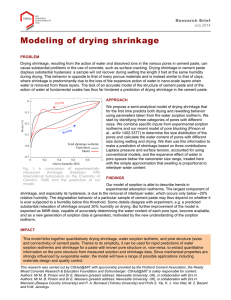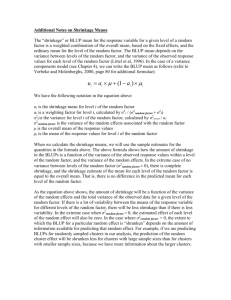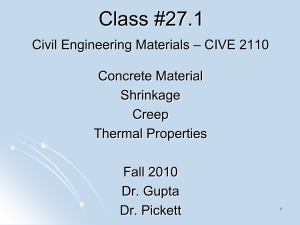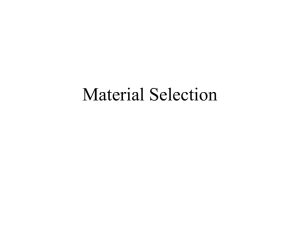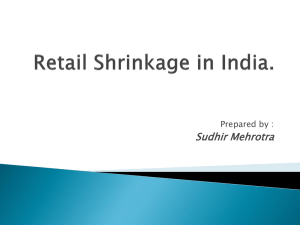George C Fanourakis, DTech(Eng), MSc(Eng), CEng, Associate
advertisement
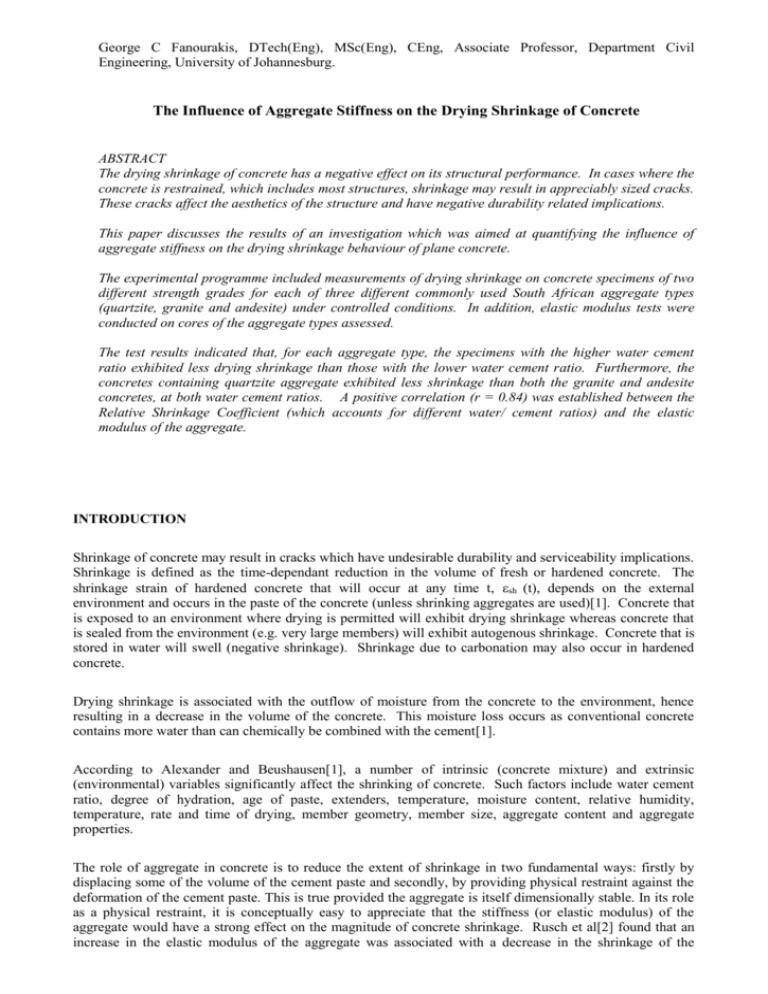
George C Fanourakis, DTech(Eng), MSc(Eng), CEng, Associate Professor, Department Civil Engineering, University of Johannesburg. The Influence of Aggregate Stiffness on the Drying Shrinkage of Concrete ABSTRACT The drying shrinkage of concrete has a negative effect on its structural performance. In cases where the concrete is restrained, which includes most structures, shrinkage may result in appreciably sized cracks. These cracks affect the aesthetics of the structure and have negative durability related implications. This paper discusses the results of an investigation which was aimed at quantifying the influence of aggregate stiffness on the drying shrinkage behaviour of plane concrete. The experimental programme included measurements of drying shrinkage on concrete specimens of two different strength grades for each of three different commonly used South African aggregate types (quartzite, granite and andesite) under controlled conditions. In addition, elastic modulus tests were conducted on cores of the aggregate types assessed. The test results indicated that, for each aggregate type, the specimens with the higher water cement ratio exhibited less drying shrinkage than those with the lower water cement ratio. Furthermore, the concretes containing quartzite aggregate exhibited less shrinkage than both the granite and andesite concretes, at both water cement ratios. A positive correlation (r = 0.84) was established between the Relative Shrinkage Coefficient (which accounts for different water/ cement ratios) and the elastic modulus of the aggregate. INTRODUCTION Shrinkage of concrete may result in cracks which have undesirable durability and serviceability implications. Shrinkage is defined as the time-dependant reduction in the volume of fresh or hardened concrete. The shrinkage strain of hardened concrete that will occur at any time t, sh (t), depends on the external environment and occurs in the paste of the concrete (unless shrinking aggregates are used)[1]. Concrete that is exposed to an environment where drying is permitted will exhibit drying shrinkage whereas concrete that is sealed from the environment (e.g. very large members) will exhibit autogenous shrinkage. Concrete that is stored in water will swell (negative shrinkage). Shrinkage due to carbonation may also occur in hardened concrete. Drying shrinkage is associated with the outflow of moisture from the concrete to the environment, hence resulting in a decrease in the volume of the concrete. This moisture loss occurs as conventional concrete contains more water than can chemically be combined with the cement[1]. According to Alexander and Beushausen[1], a number of intrinsic (concrete mixture) and extrinsic (environmental) variables significantly affect the shrinking of concrete. Such factors include water cement ratio, degree of hydration, age of paste, extenders, temperature, moisture content, relative humidity, temperature, rate and time of drying, member geometry, member size, aggregate content and aggregate properties. The role of aggregate in concrete is to reduce the extent of shrinkage in two fundamental ways: firstly by displacing some of the volume of the cement paste and secondly, by providing physical restraint against the deformation of the cement paste. This is true provided the aggregate is itself dimensionally stable. In its role as a physical restraint, it is conceptually easy to appreciate that the stiffness (or elastic modulus) of the aggregate would have a strong effect on the magnitude of concrete shrinkage. Rusch et al[2] found that an increase in the elastic modulus of the aggregate was associated with a decrease in the shrinkage of the concrete. This effect was indirectly confirmed by Reichard[3], who considered the effect of the elastic modulus of concretes (with constant aggregate contents and water cement ratio) on shrinkage. Research by Davis and Alexander[4] considered eight of the most commonly used South African aggregate types, from 23 sources throughout the country. The results of this investigation led to the establishment of empirical “relative shrinkage” values, ranging from approximately 0.6 to 1.7, for the different aggregate types. This important work illustrated that it was possible to cause a more than doubling of the shrinkage deformation in concrete by simply altering the geological type of the aggregate. However, the work did not definitively separate the influence of the aggregate stiffness from other possible properties related to the aggregate type. The purpose of the investigation reported here was to determine the influence of aggregate type and stiffness on the shrinkage behaviour of plain concrete over a period of 140 days. The specific objectives of this research were to: Assess the differences in the shrinkage behaviour of concretes of two different w/c ratios each containing one of three different commonly used South African aggregate types. The aggregate types considered were quartzite, granite and andesite from quarries in Pretoria and Johannesburg, South Africa; Determine the correlation between the relative shrinkage of concrete and the elastic modulus of the included aggregate; Compare the above findings to those of Davis and Alexander[4], whose research included concretes containing quartzite or granite or andesite from the same sources as those used in this research. EXPERIMENTAL DETAILS Materials A single batch of CEM I 42,5 cement from the Dudfield factory of Alpha Cement was used for all the tests carried out in this investigation. Quartzite (Q) from the Ferro quarry in Pretoria, granite (G) from the Jukskei quarry in Midrand and andesite (A) from the Eikenhof quarry in Johannesburg were used as both the stone and sand aggregates for the concrete. The stone was 19 mm nominal size and the fine aggregate was crusher sand. Two rock boulders were collected from each of the quartzite (Ferro) and andesite (Eikenhof) quarries for the determination of the elastic modulus of the rock. Since the rocks observed in the Granite (Jukskei) quarry appeared quite variable, two boulders with visually different characteristics were collected from this quarry. All these boulders were obtained from the same areas in the respective quarries where rock material was obtained to produce the aggregates used to make the concrete samples for this investigation. Laboratory Procedures Determination of elastic moduli of the aggregates Measurements of aggregate elastic modulus or stiffness were carried out on samples obtained from the representative boulders collected as described above. The stiffness of each rock type as determined on the boulder samples was taken to be representative of the stiffness of the corresponding aggregates used in the concrete specimens. Three cores measuring 42 mm in diameter and 82 mm long were cut from each set of two boulders and these were tested according to the procedure described in BS 1881[5] to determine the elastic modulus of the aggregates used in this investigation. Two LVDT displacement gauges were attached diametrically opposite each other on each core and strain measurements were taken over a length of 50 mm. The cores were tested in the Amsler type 103 compression testing machine which has a capacity of 2000 kN. The load and axial deformations of the specimens were autographically recorded by a Graphtech Data Recorder on an XY plotter over one cycle of loading and unloading. The cores were loaded to a maximum stress equal to approximately 25 per cent of the average unconfined compression strength values respectively determined by Davis and Alexander[4] as 250 MPa, 190 MPa and 527 MPa for the quartzite, granite and andesite from the same sources. Concrete mixture proportions A total of six mixtures were prepared, using water/cement (w/c) ratios of 0.56 and 0.4, for each of the three aggregate types included in the investigation. For each mix, a constant water content of 195 l/m3 was used. The w/c ratios of 0.56 and 0.4 were chosen to respectively represent typical medium and high strength concretes used in practice. This approach ensured that, for the different aggregate types used, concretes with the same w/c ratio had the same volume of cement paste. Table 1 shows the mix proportions of the six concretes as well as the slump values and (cube) compressive strengths obtained for the concretes. Tab. 1 Mix Proportions and slump test results of the concrete used in this investigation Quartzite Aggregate Type Granite Andesite Q1 Q2 G1 G2 A1 A2 195 195 195 195 195 195 348 488 348 488 348 488 19 mm Stone (kg/m ) 1015 1015 965 965 1135 1135 Crusher Sand (kg/m3) 810 695 880 765 860 732 w/c Ratio a/c Ratio Slump (mm) Compressive Strength (MPa) 0.56 5.24 90 37 0.4 3.50 50 65 0.56 5.30 115 38 0.4 3.55 70 65 0.56 5.73 95 48 0.4 3.83 55 74 Mix Reference Water (l/m3) 3 Cement (kg/m ) 3 Preparation of concrete specimens Six 100 mm cubes were cast for each of the six mixes. In the case of each mix, three cubes were tested at seven days and three at 28 days after casting. The 28 day strength of each concrete, which is shown in Table 1, was taken as the average of the three compressive strength tests at that age. For each concrete type, three prisms, measuring 101.6 x 101.6 x 200 mm, were prepared for the shrinkage testing. All the concrete samples were cured in a water bath, at a temperature maintained at 22 1 C. At approximately 21 days after casting, the prisms were removed from the curing bath and Demec targets were glued onto two opposite, formed sides of each prism, on a vertical axis symmetrically about the middle of the specimen, to accommodate a 100 mm Demec strain gauge. A quick-setting glue (Schnellklebstoff X 60 Epoxy Glue) which adheres to wet concrete was used for this purpose. After the glue had set (approximately 15 minutes after application) the prisms were returned to the curing bath where they remained for a total of 28 days after casting. Shrinkage tests The prisms were removed from the curing bath at age of 28 days after casting and placed on a rack, as shown in Figure 1. Fig.1 Drying shrinkage samples By means of an air conditioner and humidifier, the temperature and relative humidity in the room in which the frames were housed was kept between 23 3 C and 65 5 C, respectively. Shrinkage strains were measured on three specimens of each mix, using a 100 mm Demec gauge across steel targets which had been glued onto opposite faces of the test prism. The Demec gauge is accurate to approximately 17 microstrain. Strains were measured daily for one week, weekly until the end of one month, and approximately monthly thereafter for a total period of almost six months. However, a breakdown of the air conditioner, which occurred approximately a week before the end of the test programme, affected the final measurements. Therefore, these measurements were excluded and hence only the initial 140 day period (after curing) was considered. At each measuring period, the strain of each prism was taken as the average of the strains measured on the two opposite faces of the prism. The strain of each group of three prisms was taken as the average of the strains of the prisms in that group. RESULTS AND DISCUSSION Shrinkage strains The average cumulative drying shrinkage strain with time measured on the specimens of mixes with a w/c ratio of 0.56 (Q1, G1, A1) and those measured on the specimens with a w/c ratio of 0.4 (Q2, G2, A2) are shown in Figures 2 and 3, which are plotted to the same scale. Cumulative Drying Shrinkage Strain (x10E-6) 400 300 200 Q1 G1 A1 100 0 0 20 40 120 100 80 60 Time of Drying (Days) 140 Fig. 2 Cumulative drying shrinkage strain versus time of drying for specimens with a w/c ratio of 0.56 Cumulative Drying Shrinkage Strain (x10E-6) 400 300 200 Q2 G2 A2 100 0 0 20 40 60 80 100 Time of Drying (Days) 120 140 Fig. 3 Cumulative drying shrinkage strain versus time of drying for specimens with a w/c ratio of 0.4 With reference to Figures 2 and 3, it is evident that, for each aggregate type, the specimens with the higher w/c ratio (0.56) exhibited less drying shrinkage than those with the lower w/c ratio (0.4). In addition, it was noted that the difference between the shrinkage of the two strength grades of each aggregate type appears to reduce with time and the rate of shrinkage of all the mixes decreases with time. These trends are in agreement with the findings of Alexander[6]. Furthermore, the concretes containing quartzite aggregate displayed less shrinkage than both the granite and andesite concretes, for both w/c ratios. This was in agreement with the findings of Davis and Alexander[4]. The specimens containing granite exhibited similar shrinkage to those containing andesite in the case of the high w/c ratio, but more shrinkage than the andesite in the comparison of specimens with the lower w/c ratio. Correlation of shrinkage with elastic modulus of the aggregate The measured elastic moduli, ranges and averages for each of the three aggregate types (determined in this research) are shown in Table 2. The results for the granite represent the range and the average for the six cores tested, as the visually different boulders did not show different results. This table also includes the range and average values determined by Davis and Alexander[4] for the same aggregates from the same sources. For the purposes of comparing the influence of aggregate alone on shrinkage, the shrinkage values at 140 days after the start of the test programme were modified to account for the different w/c ratios. This modification, which was similar to one carried out by Davis and Alexander[4], entailed adjusting the shrinkage values by the ratio of their compressive strengths at 28 days to the mean of the compressive strengths of all six mixes (54.5 MPa). The average of the two adjusted shrinkage values for each aggregate type was then expressed as a ratio of the mean of the six adjusted values (362.7 x 10-6), to obtain a relative shrinkage value for each aggregate type. The adjustment factors, adjusted shrinkage values and relative shrinkage factors are given in Table 3, which includes the relative shrinkage values determined by Davis and Alexander[4] for the same aggregates as those considered in this investigation, but pertaining to an age of 325 days in the case of the quartzite and andesite and 110 days for the granite (all of which were extrapolated to 5 years). Tab. 2 Results of elastic moduli tests on cores Aggregate Type Quartzite (Ferro) Granite (Jukskei) Andesite (Eikenhof) Elastic Moduli of Rock Cores Measured Davis and Alexander[4] Range (GPa) Mean (GPa) Range (GPa) Mean (GPa) 59 - 88 73 42 - 98 70 66 - 80 70 27 - 93 60 82 - 94 89 80 - 110 95 Tab. 3 Adjusted specific shrinkage values, elastic moduli and relative shrinkage coefficients Mix Q1 Q2 G1 G2 A1 A2 Adjustment Factor 0.679 1.193 0.697 1.193 0.880 1.358 Measured Shrinkage at 140 days Mean for Actual Adjusted Aggregate (x10-6 ) (x10-6 ) (x10-6 ) 287 195 370 441 318 354 247 392 468 358 367 323 370 502 413 Davis and Alexander[4] E (GPa) Relative Shrinkage E (GPa) Relative Shrinkage 73 0.88 70 0.83 70 0.99 60 0.94 89 1.14 95 1.13 Figure 4 shows a correlation of the relative shrinkage with average elastic modulus of the aggregate using the shrinkage results from this investigation and from the work by Davis and Alexander[4]. The letters Q,G and A denote quartzite, granite and andesite concretes, respectively. The results in Figure 4 indicate significant variations in the stiffness of aggregates from a particular source. Furthermore, the results show that, counterintuitively, the higher the average elastic modulus of an aggregate, the higher the relative shrinkage of the concrete. The regression equations and correlation coefficients applicable to the results from this investigation and from Davis and Alexander’s work[4], when considered separately and together, are given in Table 4. 1.4 Measured 1.3 Davis and Alexander 1.2 Relative Shrinkage A 1.1 1 A G G Line A 0.9 Q Q Line B 0.8 0.7 50 60 70 80 90 100 Average Modulus of Elasticity of Aggregate (GPa) Fig. 4 Relationship between relative shrinkage and elastic modulus of aggregates Tab. 4 Correlation of relative shrinkage and average modulus of elasticity of aggregates Line A B Data Source Measured Davis and Alexander[4] Combined Regression Equation y = 0.011x + 0.164 y = 0.007x + 0.465 y = 0.008x + 0.396 Correlation Coefficient (r) 0.840 0.795 0.795 The correlations in Figure 4 show an opposite trend to that reported by Rusch et al[2] and Reichard[3], which indicated that the higher the elastic modulus of the aggregate the greater the restraint offered by the aggregate to the shrinkage of the paste. CONCLUSIONS The results of this research indicated that no obvious trend exists regarding the shrinkage of concretes containing granite or andesite aggregates, despite a difference of approximately 20 GPa in the average elastic moduli values of these aggregates. However, in the case of concretes of both water cement ratio mixes included in this research, the concrete containing quartzite exhibited the least shrinkage. Furthermore, no correlation was found to exist between the shrinkage of concrete and the stiffness of the included aggregate. When considering the relative shrinkage values at 140 days, a positive correlation was found to exist between the relative shrinkage of concrete and the elastic modulus of the included aggregate. For the concretes of each aggregate type, the higher the elastic modulus of the aggregate, the more the relative shrinkage of the concrete. An identical trend was established using data from Davis and Alexander[4] for the same aggregates. These correlations show an opposite trend to that established by Rusch et al[2] and Reichard[3] which indicated that the higher the elastic modulus of the aggregate, the greater the restraint offered by the aggregate to the shrinkage of the concrete. However, an analysis by Asamoto et al[7] concluded that the elastic modulus of aggregate was not solely responsible for the shrinkage of concrete. From the above, it is clear that, for the aggregates assessed, the effect of variations in the elastic modulus of the aggregate on shrinkage is overshadowed by other factors which appear to be related to the geological origin of the aggregate but remain un-quantified at this stage. REFERENCES [1]Alexander, M.G. and Beushausen, H. (2009) Deformation and Volume Change of Hardened Concrete, Fulton’s Concrete Technology, Ed. G. Owens, Ninth edition, Cement and Concrete Institute, Midrand, South Africa, pp. 133142. [2]Rusch, H., Kordina, K. and Hilsdorf, H.K. (1962) Der einfluss des mineralogischen charakters der zuschlage auf das kriechen von beton, Deutscher Ausschuss fur Stahlbeton, Berlin, No. 146, pp. 19-133. [3]Reichard, T.W. (1964) Creep and Drying Shrinkage of Lightweight and Normal Weight Concrete, Washington, DC: National Bureau of Standards, (Monograph no. 74). [4]Davis and Alexander (1992) Properties of Aggregates in Concrete (Part 2), Hippo Quarries Technical Publication, Sandton, South Africa, Mar., pp. 1-27, 42-43, 46-47. [5]BS 1881 (1983) Testing Concrete, Part 121: Method for Determination of Static Modulus of Elasticity in Compression, London: British Standards Institution. [6]Alexander, M.G. (1993b) Two experimental techniques for studying the effects of the interfacial zone between cement paste and rock, Cement and Concrete Research, Vol. 23, No. 3, May, pp. 567-576. [7]Asamoto, S., Ishida, T. and Maekawa, K. (2008) Investigations into volumetric stability of aggregates and shrinkage of concrete as a composite, Journal of Advanced Concrete Technology, Vol. 6, No. 1, pp. 77-90.

